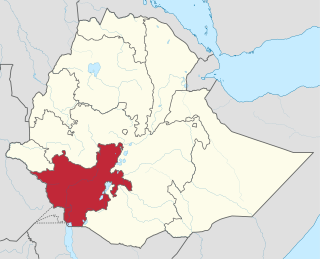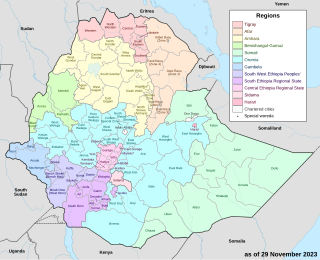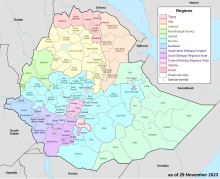Demographics
Based on the 2007 census conducted by the Central Statistical Agency of Ethiopia (CSA), Gurage has a total population of 1,280,483. [4] The six largest ethnic groups reported in Gurage Zone were the Gurage people (82%), the Mareqo or Libido (4.28%), the Amhara (3.36%), the Kebena (3.34%), the Silt'e people (2.71%), and the Oromo (1.69%); all other ethnic groups made up 2.62% of the population. Gurage languages are spoken as a first language by 80.54% of the population, 5.28% spoke Amharic, 4.09% spoke Libido, 3.2% spoke Kebena, 2.98% spoke Silt'e, and 1.06% spoke Oromo; the remaining 2.85% spoke all other primary languages reported. The majority of the inhabitants were reported as Muslim, with 51.91% of the population reporting that belief, while 41.02% practised Ethiopian Orthodox Christianity, 5.79% were Protestants, and 1.12% Catholic. [5]
According to a May 24, 2004 World Bank memorandum, 3% of the inhabitants of Gurage have access to electricity, this zone has a road density of 95.4 kilometers per 1000 square kilometers, the average rural household has 0.5 hectare of land (compared to the national average of 1.01 hectare of land and an average of 0.89 for the SNNPR) [6] the equivalent of 0.2 heads of livestock. 18.9% of the population is in non-farm related jobs, compared to the national average of 25% and a Regional average of 32%. 79% of all eligible children are enrolled in primary school, and 12% in secondary schools. 18% of the zone is exposed to malaria, and 38% to Tsetse fly. The memorandum gave this zone a drought risk rating of 319. [7]

The Southern Nations, Nationalities, and Peoples' Region was a regional state in southwestern Ethiopia. It was formed from the merger of five kililoch, called Regions 7 to 11, following the regional council elections on 21 June 1992. Its government was based in Hawassa.

East Shewa is a zone in Oromia Region of Ethiopia. East Shewa is located at the center of oromia Oromia, connecting the western regions to the eastern ones. This zone is bordered on the south by the West Arsi Zone, on the southwest by the Southern Nations, Nationalities and Peoples Region, on the west by Southwest Shewa Zone and Oromia Special Zone Surrounding Finfinne, on the northwest by North Shewa, on the north by the Amhara Region, on the northeast by the Afar Region, and on the southeast by Arsi; its westernmost reach is defined by the course of the Bilate River. Towns and cities in East Shewa include Dukam, Galan, Tullu Dimt, Basaqa and Aqaqi, Bishoftu, Metehara, Batu Dambal and Adama. With the intent to rehabilitate degraded forests, the Zonal Agriculture and Rural Development Office announced 2 October 2, 2006, that it had planted over 36.3 million seedlings in 10 of the Zone's 12 woredas, covering 4,000 hectares of land.

Gedeo is a zone in the South Ethiopia Regional State (SERS) of Ethiopia. This zone is named for the Gedeo people, whose homelands lie in this zone. Gedeo is an exclave of the SERS consisting of a narrow strip of land along the eastern escarpment of the Ethiopian Highlands. It is surrounded by the Oromia Region, which borders the Zone on the east, south and west; Gedeo shares its northern boundary with the Sidama Region. Dilla is the administrative center; other towns include Dilla, Wonago, Yirgachefe, Chelelekitu and Gedeb.

Yem Zone is one of the zones in the Central Ethiopia Regional State. Yem is named for the Yem, people whose homeland lies in this zone,. Yem is bordered on the west and north by the Oromia Region, and separated from Gurage on the northeast and Hadiya on the east by the Omo River. High points in Yem include Mount Bor Ama, Mount Azulu and Mount Toba. The administrative center of Yem is Saja.

Hadiya is a zone in the Central Ethiopia Regional State of Ethiopia. This zone is named after the Hadiya of the Hadiya Kingdom, whose homeland covers part of the administrative division. Hadiya is bordered on the south by Kembata, on the southwest by the Dawro Zone, on the west by the Omo River which separates it from Oromia Region and the Yem Special Woreda, on the north by Gurage, on the northeast by Silte, and on the east by the Alaba Zone; the woredas of Mirab Badawacho and Misraq Badawacho form an exclave separated from the rest of the zone by Kembata. The administrative center of Hadiya is Hosaena.

Kembata is a zone in the Central Ethiopia Regional State of Ethiopia. It was formerly known as Kembata, Alaba and Tembaro, until Alaba and Tembaro became a special woreda in 2002 and 2023 respectively. This zone is named after the Kambaata people which gained zonal posture following the establishment of Central Ethiopian region in 2023.
Damot Gale is a woreda in South Ethiopia Regional State, Ethiopia. Part of the Wolayita Zone, Damot Gale is bordered on the southwest by Sodo Zuria, on the northwest by Boloso Sore and Damot Pulasa, on the north by the Hadiya Zone, on the east by Diguna Fango, and on the southeast by Damot Weyde. The administrative center of Damot Gale is Boditi. Damot Pulasa woreda was separated from Damot Gale.
Silti (ስልጢ) is one of the zones in the Central Ethiopia Regional State of Ethiopia. It is named after a subgroup of the Silt'e people, whose homeland includes this zone. Formerly part of the Gurage Zone, after a referendum held between 18 and 26 April 2001, this woreda became part of the Silt'e Zone. This woreda is bordered on the south by Lanfro and Dalocha, on the southwest by Wulbareg, on the west by Alicho Werero, on the north by the Gurage Zone, and on the east by the Oromia Region. The administrative center of this woreda is Kibet; other towns in Silti include Alkaso, and Werabe. Southwestern part of this woreda was added to Wulbareg woreda.
Gumer is one of the woredas in the Southern Nations, Nationalities, and Peoples' Region of Ethiopia. This woreda is named after one of the sub-groups of the Sebat Bet Gurage, the Gumer. Part of the Gurage Zone, Gumer is bordered on the southeast by the Silt'e Zone, on the southwest by Geta, on the northwest by Cheha, and on the north by Ezha. Towns in Gumer include Arek'it and B'ole. Geta and Alicho Werero woredas were separated from Gumer.
Enemorina Eaner is one of the woredas in the Southern Nations, Nationalities, and Peoples' Region of Ethiopia. This woreda is named in part after one of the sub-groups of the Sebat Bet Gurage, the Enemor, who are first mentioned in a list of groups paying tribute to Emperor Yeshaq I, and other sub-group, Eaner. Part of the Gurage Zone, Enemorina Eaner is bordered on the south by the Hadiya Zone, on the southwest by Yem special woreda, on the west by Oromia Region, on the north by Cheha, on the east by Geta, and on the southeast by Endegagn. The administrative center of Enemorina Eaner is Gunchire. Endegagn was separated from this woreda.
Leemo is one of the woredas in the Central Ethiopia Regional State of Ethiopia. The relationship of the name of this woreda to that of the medieval kingdom in the Gibe region is unclear. A part of the Hadiya Zone, Limo is bordered on the south by the Kembata Tembaro Zone, on the southwest by Duna and Soro, on the west by Gomibora, on the northwest by Misha, on the northeast by Ana Lemo, and on the southeast by Shashogo. Towns in Lemo include Belesa and Lisana. The town of Hosaena is surrounded by Limo. Parts of Limo woreda were separated to create Ana Lemo, Hosaena, Mirab Azernet Berbere and Misraq Azernet Berbere woredas.
Badawacho was one of the 77 woredas in the Southern Nations, Nationalities, and Peoples' Region of Ethiopia. A triangle-shaped exclave of the Hadiya Zone, Badawacho was bordered on the south by the Wolayita Zone, on the west and north by the Kembata Tembaro Zone, and on the east by the Oromia Region and Sidama Zone. Badawacho has got three small lakes: Budamada - deepest of all three, Tiello and Matchafara - home for hippopotamus and variety of birds. The Bilate River which separates the three lakes is also home for crocodiles and hippopotamus. The major town in Badawacho was Shone. Badawacho was separated for Mirab Badawacho and Misraq Badawacho woredas.
Seden Sodo is one of the woredas in Oromia Region, Ethiopia. it is bordered on the Southern Nations, Nationalities and Peoples Region, Gedebeno Gutezer Wereda or Gurage zone on the west by weliso, by north by Bacho wereda on the northeast by Tole wereda, and on the east by Kersa Malima. The major town in Seden Sodo is Harbu Chulule.
Sokoru is one of the woredas in the Oromia Region of Ethiopia. This woreda is named after the former awraja of the same name, and covering much of the same territory as the current woreda, as well as its administrative center, Sokoru. Part of the Jimma Zone, Sokoru is bordered on the south by Omo Nada, on the west by Tiro Afeta, and on the north and east by the Southern Nations, Nationalities and Peoples Region; the Gibe River defines the northern boundary. Other towns in this woreda include Deneba, Kumbi and Natri.
Nannawa Adama is a woreda in Oromia Region, Ethiopia. Part of the East Shewa Zone located in the Great Rift Valley, Adama Zuria is bordered on the south by the Arsi Zone, on the southwest by Koka Reservoir which separates it from Dugda Bora, on the west by Lome, on the north by the Amhara Region, and on the east by Boset; the Awash River, the only important river in this woreda, defines the woreda boundaries on the east and south. Other towns in this woreda include Awash Melkasa, Shewa Alemtena, Sire Robi, Sodere and Wenji Gefersa.
Dugda is a district in the Oromia Region of Ethiopia. It was part of the former district of Dugda Bora before being divided into Bora and Dugda. Part of the East Shewa Zone located in the Great Rift Valley, Dugda is bordered on the southeast by Hora-Dambal, on the south by Adami Tullu and Jido Kombolcha, on the west by the Southern Nations, Nationalities and Peoples Region, on the northwest by the Southwest Shewa Zone, on the north by the Awash River which separates it from Ada'a Chukala, on the northeast by Koka Reservoir which separates it from Adama, and on the east by the Arsi Zone. The administrative center of Dugda is Meki.
Adami Tullu and Jido Kombolcha is one of the districts in the Oromia Region of Ethiopia. Part of the East Shewa Zone located in the Great Rift Valley, Adami Tullu and Jido Kombolcha is bordered on the south by West Arsi Zone with which it shares the shores of Lakes Abijatta and Langano, on the west by the Silte Zone of Southern Nations, Nationalities and Peoples Region, on the north by Dugda Bora, on the northeast by Hora-Dambal, and on the east by the Arsi Zone. The main town of district is Adami Tullu; other towns include Abosa, Bulbulla, and Jido.
Tiyo is a woreda in Oromia Region, Ethiopia. Part of the Arsi Zone, Tiyo is bordered on the south by Munesa, on the west by Batu Dugda, on the northeast by Hitosa, and on the southeast by Digeluna Tijo. The administrative center of the woreda and Zone is Asella; other towns in Tiyo include Gonde.
Adola is one of the woredas in the Oromia Region of Ethiopia. It is part of former Adolana Wadera woreda what was divided for Adola, Girja and Wadera woredas and Adola town. Part of the Guji Zone, Adolana Wadera was bordered on the south by Liben, on the southwest by Odo Shakiso, on the west by Bore, on the north by the Southern Nations, Nationalities, and Peoples Region, and on the east by the Bale Zone.
Abaya is a woreda in the Oromia Region, Ethiopia. It is part of former Gelana Abaya woreda what was divided for Abaya and Gelana woredas. Part of the Borena Zone, Gelana Abaya was bordered on the south by Hagere Mariam, and on the west, north and east by the Southern Nations, Nationalities, and Peoples Region (SNNPR). Lake Abaya, on the western border, is divided between this woreda and the SNNPR. However, the Guji Oromo who live in Nechisar National Park are claimed to be administratively part of this woreda, in a kebele called "Irgansaa".


